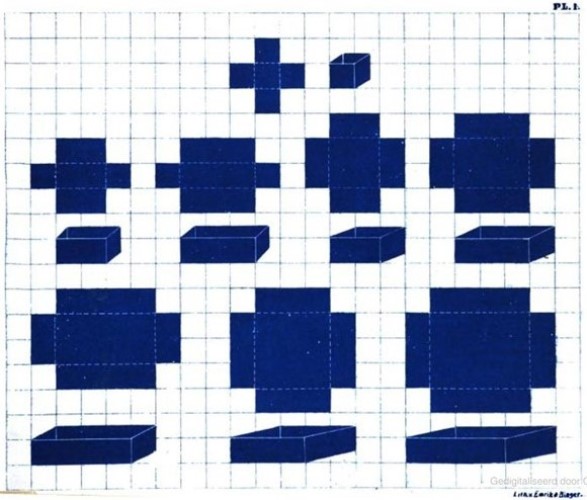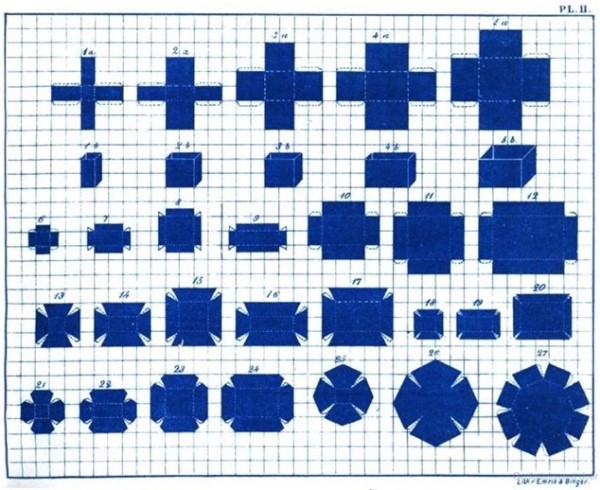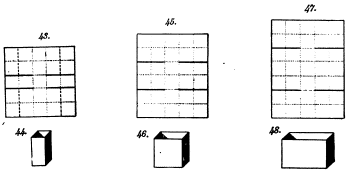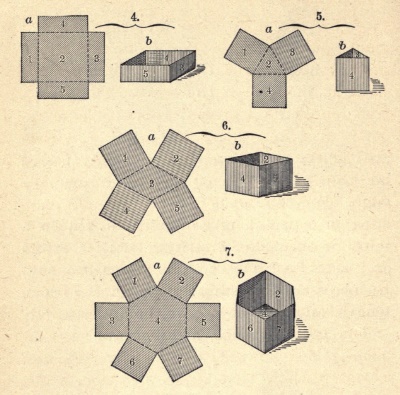| The Public Paperfolding History Project
Last updated 18/11/2025 x |
|||||||
| The Froebelian Occupation of Box Making | |||||||
This page is being used to collect information about the history of the Froebelian Occupation of Box Making. Please contact me if you know any of this information is incorrect or if you have any other information that should be added. Thank you. The construction of boxes from irregular nets and from slit rectangles could be considered two different topics. However, for now, information about both is being collected on this page, on the basis that we do not know which of the techniques was used in the very early kindergartens. ********** 1848 'Die Kindergärten' by Wilhelm Middendorf was published by Verlagsbuchhandlung der Kindheit und Jugendbeschäftigungsanstadt in Blankenberg and Rudolfstadt in 1848. It contains a description of children 'forming and glueing boxes and containers for storing seeds from their flowerbeds and other small things'. ********** Prior to 1852 Part Two of 'Friedrich Froebel's Gesammelte padogogische schriften' (Friedrich Froebel's Collected Educational Writings) edited by Wichard Lange, which was published in two parts in 1862, contains reference to ther making of boxes of various kinds. Froebel does not explain how these boxes are to be made, except that they are from folded paper.
********** 1865 'De Fröbelsche kartonwerkers' by Elise Van Calcar, which was published by K H Schadd in Amsterdam in 1863, linked Cardboard Modelling to Froebel but without explaining why. Inter alia, the work contains two plates showing designs for boxes.
*********** 1873 Irregular nets for boxes of various shapes appear in 'Die Praxis Des Kindergartens' by August Koehler, which was published by Herman Bohlau in Weimar in 1873.
********** 1876 'Die Formenarbeiten Part 6: Die Papparbeiten' (Cardboard Modelling) by Alois Fellner was published by Wien, A. Pichler's Witwe & Sohn during the years 1874/79. The designs fall into three categories, boxes, polyhedra and life forms (in this case buildings). Inter alia, the author says, roughly translated: 'Das Pappen has limited use in kindergarten, as it requires considerable dexterity ... and tools that require careful handling. To banish it entirely would be throwing the baby out with the bathwater ... Therefore the kindergarten teacher should give her pupils all the necessary materials for making boxes, fully prepared ... The five to six year old children will soon have completed a number of boxes and will look with great joy at the seeds needed in kindergarten ...'
********** 1880 In 'Maakt de Kinderen Gelukkig' by Elise Van Calcar, which was published by H C Van Calcar in Gravenhage in 1880, there is reference to Cardboard Modelling as a Froebelian occupation. Inter alia the author says, roughly translated: 'you can even use cards (presumably playing cards)to learn the basics, as they can be handled with scissors and it doesn't matter if you make mistakes. It's even recommended to have the children build houses of cards from regular playing cards first to prepare the hand to fold clean, straight lines, or to practice folding and cutting out small wallets or boxes, which one folds from a piece of paper cut into the shape of a cross. Children like to make a series of square boxes that fit inside each other in increasing size.' and 'Always first carefully draw the base and sides of the object one wishes to make on the cardboard, remembering to leave a seam or edge on each piece wide enough to be glued to the adjacent side piece.' ********** 'Kleiner Kindergarten' by Karl Schellner, which was published by Alfred Holder in Vienna in 1880, contains a section about 'Das Pappen' which says, inter alia, 'This activity is less suitable for children of pre-school age, but more so for pupils in the upper grades of of elementary and middle school, who are not only supposed to make the boxes necessary for the various teaching materials eg seeds, minerals etc, but also, according to the prescribed curriculum, to produce geometric solids from nets they have drawn themselves'. The final sentences describe how to make a simple open box by cutting out a template, folding up the sides and joining the sides together with paper or canvas strips pasted over the joints.
********** 1882 Instructions for making several boxes from slit rectangles appear in the Cardboard Modelling chapter of Part Two of 'The Kindergarten Guide' by Maria Kraus Boelte and John Kraus, which was published by E. Steiger and Company in New York and by George Philip and Son in London,. probably in 1882.
********** 1887 In 'Primary Methods: A Complete and Methodical Presentation of the Use of Kindergarten Material in the Primary School' by W N Hailmann was published by A S Barnes and Company in New York and Chicago in 1887.
********** |
|||||||








